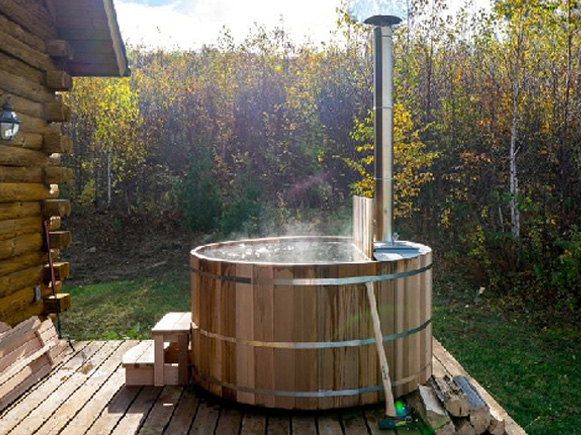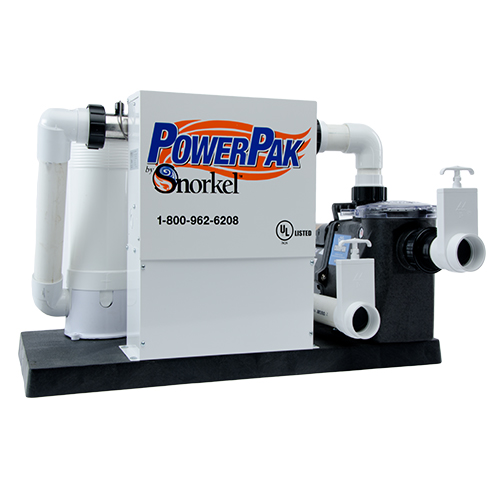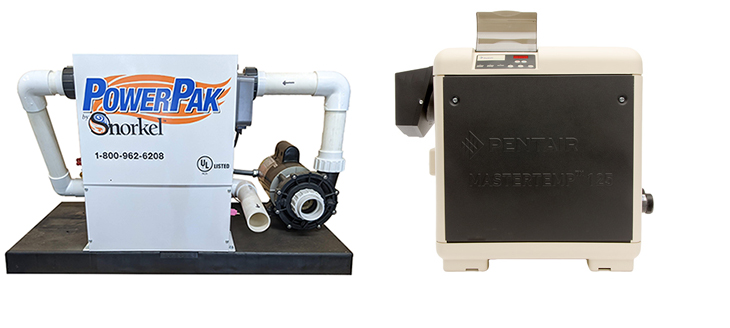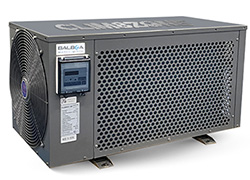Heating Systems Overview
Snorkel Hot Tubs offers 4 different heat sources for heating your hot tub, wood-fired, gas (both natural gas and LP)
electric heat and the new Balboa heat pump/chiller. Each of the heating systems has its own pros and cons, which are
summarized below. Wood-fired heating is discussed in depth under the wood-fired hot tub section.
WOOD-FIRED
Wood-fired systems are great for people in more exurban or rural areas where wood is typically available at little or even no cost and a little wood smoke won’t upset the neighbors. The most important consideration, though, is that this type of heating has to fit your lifestyle. Like sailing v. power boating, you have to enjoy the process of getting there.
There is truly something unique about wood-fired hot tubbing. Part of it is the simple act of building and tending a fire. Then, once in the tub, you enjoy not just the warmth of the water, but the comforting sound of a crackling fire, reminiscent of youthful camping and campfires.
Most wood-fired hot tub owners truly enjoy the process of building a fire, tending it and watching the tub get up to temperature. But, if you want your tub to be heated and available all the time, wood-fired heating is probably not the best choice. You need to have the time to build and feed a fire and wait for the water to heat up. Most important, you have to enjoy the process. If it is a chore and drudgery to build and tend a fire, the hot tub will not see much use.
That said, age and circumstances change for people. Customers who thoroughly enjoyed their wood-fired hot tub found that after 10 or 12 years (and a little arthritis) upgrading to an electric or gas heated tub was a better fit their changing needs.


ELECTRIC HEATING
Electric heat is by far the most popular heating method for all spas and hot tubs. It is relatively easy and inexpensive (compared to gas) to install and maintain. And, because most people using electric heat keep their tub at or near tubbing temperature, they are almost always just waiting for you to jump in.
The main downside of electric heat can be operating cost if you live in an area of high electric rates. Using both a floating (on the surface of the water) foam cover along with the standard insulating vinyl cover can go a long ways in mitigating heat loss and reducing the electric bill. The new Balboa Clim8zone heat pump also goes a long ways to help save on electricity.
Both the Original Pak™ and Power Pak™ electric heaters we sell are made by HydroQuip, a preeminent supplier to the hot tub, spa and jetted bath industries since 1981
GAS HEATING
The principal benefit of gas heaters is their BTU output and their ability to heat up the water quickly. The standard size gas heater we sell is the Pentair MasterTemp 125, rated at 125,000 BTUs per hour. That is equal to about a 37kW electric heater, about 3.7 times more heat output than our standard size 10kW electric heater.
In addition to the rapid heat up times, gas is usually quite a bit cheaper than electricity per heating unit. Another reason to consider gas is a potential lack of electric panel capacity for the load of an electric heater. However, the cost of increasing panel capacity may not be much different than the higher cost of purchase and installation of a gas heater.
While the ability to heat your tub up 3.7 times faster and at a cheaper cost might seem to be huge benefits, there are a number disadvantages to gas heat. Gas heaters are substantially more expensive to purchase and install.
A gas line will have to be run from the nearest source to the heater and it will require a trench to be dug to accommodate it. This will require a qualified gas technician as does the hookup of the heater. Installation by a non-qualified person voids the warranty on the heater.
Cold weather operation for gas heaters is another consideration, especially for LP gas heaters. Both LP and natural gas heaters need to be set to keep the water at least in the 75-80 degree range. Failure to do so causes condensation in the heat exchanger and will dramatically shorten the life of the heater. Also, for LP heaters, you will need a sizable tank and/or frequent refills due to the fact that cold weather causes a drop in pressure in the tank and even a half full tank may not provide enough pressure to operate the heater in really cold temperatures.
The last consideration is that rapid heat up times are typically of most concern when you clean and refill the tub with water. Everyone wants their tub to get heated up as fast as possible with the new refill, but for most people, this is typically only a once every 2-3 month occurrence.


CLIM8ZONE HEAT PUMP
Until recently, heat pumps weren’t very effective for heating hot tubs, being effective only down to about 55°. Balboa’s newest generation heat pump/chiller, the Clim8zone, sets a new standard, being able to heat the water with an ambient air temperature as low as -4°F. It also has a chilling capability so you can also turn your hot tub into cool bath in summer months or even a cold plunge.
We typically pair the Clim8zone with either our 5.5kW or 10kW Power Pak™. The Power Pak™ unit acts as the control system and the auxiliary heater provides an extra heat boost in cold months. That is important when heating up a fresh tub of water. The Clim8zone will be able to maintain temperature in most situations, but could struggle to get a fresh tub of water up to temperature when the ambient air temperature is getting close to zero.
Operating the Clim8zone is a breeze with the new Spa Touch 3 spa side control. Set the temperature and select whether you want the heat pump alone, electric heat only or both simultaneously, if necessary.